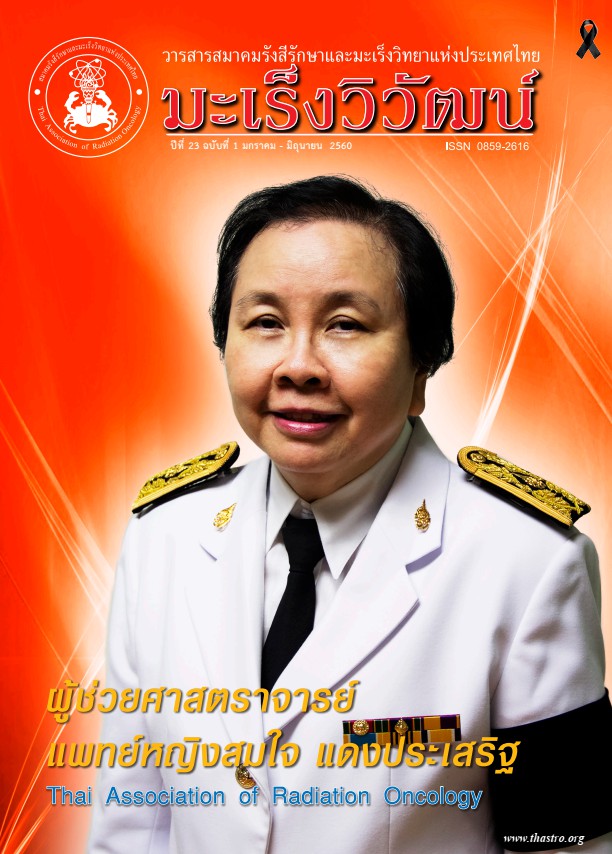Post operative radiation and chemotherapy for R1 resected Solitary fibrous tumor at nasal cavity and paranasal sinus: A case report
Abstract
Solitary fibrous tumor of head and neck region is quite rare especially in nasal cavity and paranasal sinus location. The main treatment modality for this tumor is surgery. To achieve good clinical outcomes, adequate resection is needed. The role of adjuvant radiation, in case of inadequate resection, is still debated. We present a case of a 49-year old male who had solitary fibrous tumor at left maxillary sinus. He underwent total maxillectomy and his pathological reports showed positive margin. He then received post-operative radiation at a dose of 6600 cGy and 6 cycles of chemotherapy consisted of doxorubicin, ifosfamide and mesna. Three year after complete radiation, he remained without evidence of local recurrence and distant metastasis.
References
Papadakis I, Koudounarakis E, Haniotis V, Karatzanis A, Velegrakis G. Atypical solitary fibrous tumor of the nose and maxillary sinus. Head Neck. 2013: E 77-9.
Xue Y, Chai G, Xiao F, Wang N, Mu Y, Wang Y, et al. Post-operative radiotherapy for The treatment of Malignant Solitary Fibrous tumor of the Nasal and Paranasal area. Jpn J ClinOncol. 2014; 44: 926-31.
Barnes L, Eveson JW, Reichart P, Sridransky D. World Health Organization classification of tumours. Pathology and genetics of head and neck tumours. Lyon: IARC Press; 2005.
Carlos R, Benevenuto de Andrade BA, Canedo NHS, Abrahao AC, Agostini M, Paes de Almeida, et al. Clinicopathologic and immunohistochemical features of five new cases of solitary fibrous tumor of the oral cavity. Oral Surg Oral Med Oral Pathol Oral Radiol. 2016; 121: 390-5.
Zeither DM, Kanowitz SJ, Har-EI G. Malignant Solitary Fibrous Tumor of the Nasal Cavity. Skull base. 2007; 17: 239-45.
Gold JS, Antonescu CR, Hajdu C, Ferrone CR, Hussain M, Lewis JJ, et al. Clinicopathologic correlates of solitary fibrous tumor. Cancer. 2002; 94:1057-68.
Ganly I, Patel SG, Stambuk HE, Coleman M, Ghossien R, Carson D, et al. Solitary Fibrous tumor of the head and neck: a clinicopathologic and radiologic review. Arch Otolaryngol Head Neck Surg.2006; 132: 517-25.
Wignall OJ, Moskovic EC, Thway K, Thomas JM. Solitary fibrous tumors of the soft tissues: review of the imaging and clinical features with histopathologic correlation. AJR Am J Roentgenol. 2010 ;195:W55-62.
Bishop AJ, Zagars GK, Demicco EG, Wang WL, Feig BW, Guadagnolo BA, et al. Soft Tissue Solitary Fibrous Tumor : Combined Surgery and Radiation Therapy Results in Excellent Local Control. Am J Clin Oncol. 2015 Aug 11. [Epub ahead of print]
Stacchiotti S, Libertini M, Negri T, Palassini E, Gronchi A. Fatigoni S, et al. Response to chemotherapy of solitary fibrous tumor: A retrospective study. Eur J Cancer. 2013;49:2376-83.
Downloads
Published
How to Cite
Issue
Section
License
บทความที่ได้รับการตีพิมพ์เป็นลิขสิทธิ์ของวารสารมะเร็งวิวัฒน์ ข้อความที่ปรากฏในบทความแต่ละเรื่องในวารสารวิชาการเล่มนี้เป็นความคิดเห็นส่วนตัวของผู้เขียนแต่ละท่านไม่เกี่ยวข้องกับ และบุคคลากรท่านอื่น ๆ ใน สมาคมฯ แต่อย่างใด ความรับผิดชอบองค์ประกอบทั้งหมดของบทความแต่ละเรื่องเป็นของผู้เขียนแต่ละท่าน หากมีความผิดพลาดใดๆ ผู้เขียนแต่ละท่านจะรับผิดชอบบทความของตนเองแต่ผู้เดียว




